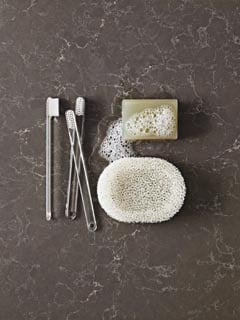Comprised from 93% natural stone, Caesarstone Quartz Surfaces are virtually scratch and stain resistant, require no sealing and are twice the strength of granite. They are also non-porous and come with a 15-year guarantee.
Marble, granite and other natural materials are unquestionably beautiful, but their extraction from core resources can come at a price – both to your pocket and the environment. Quartz has greater eco-credentials and its manufacturing process is exacting and ethical.
Caesarstone was the first quartz brand to earn ISO 14001 accreditation – the international standard for environmental preservation.
The manufacturing process starts with the selection of the finest raw materials, which are then mixed and poured into a mould that presses them into a solid slab.
Caesarstone’s Classico colours offer up to twice the resistance impact of granite – and it’s all down to the pressing, compacting and vacuuming procedure that the quartz undergoes during manufacture.
Pressure of 100tonnes – think of that as around the weight of 50 horses – is applied. Then the quartz is cured in a kiln at just under 90°C for 45 minutes.
Thanks to its composition, quartz is malleable and can be finished in some really striking ways. There are currently some innovative fabricators among the specialist companies that cut, finish and install quartz experimenting with thermoforming quartz and producing seductively curvy and fluid results.
Hand chiselling profiles on the edge of the quartz is another interesting technique that is coming to the fore.
Quartz is well established now but even so it continues to show considerable growth in the market.
Of course, exact composition of quartz materials is down to the manufacturer and brand, but as a worktop type, there can be no doubt that many retailers working in the mid to high end of the market are great proponents of Quartz.
Its flexural strength, high resistance to staining and scratching and versatility means that in many cases Quartz is winning out over alternatives.
The resemblance of Quartz to natural materials is becoming increasingly impressive, too, with colours in collections such as Caesarstone’s new 5000 series bearing an uncanny likeness to natural materials – right down to delicate veining and texture.
The 20mm thick Caesarstone continues to be a popular choice with customers. It looks great as a single 20mm profile with a simple pencil edge profile, but can also provide a cost effective solution for creating built up edge profiles from 40mm to 100mm or more.
During the past 12 months there has been an increase in traditionally designed kitchens and the use of 30mm quartz. Bullnose, double bullnose and triple bullnose edge profiles and brown tones are proving to be popular combinations for this look.
There are also some very striking neutrals emerging in the quartz sector. Blacks and variations on whites will always have their place and look unquestionably timeless, but alongside them we are seeing some stylish, subtle colour palettes of creams, greys and browns that work exceptionally well with both natural woods and chalkier paints.
In addition, advanced manufacturing techniques have meant that some Quartz brands have successfully managed to replicate the look and feel of naturally figurative stones such as marbles as never before.
Colours such as Caesarstone’s new Frosty Carrina look for all the world as though they are marble – albeit a ‘marble’ that is entirely non-porous and that has the ability to withstand scratching and staining.

